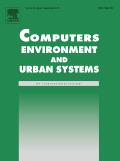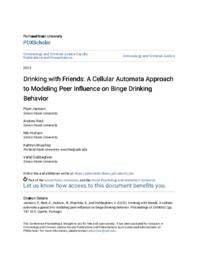Dabbaghian, Vahid
Person Preferred Name
Vahid Dabbaghian
Related Works
Content type
Digital Document
Abstract
Originally presented in the 2012 European Intelligence and Security Informatics Conference (Odense, Denmark; 22-24 August 2012).
Crime Pattern Theory argues that offenders often commit their crimes at major criminal attractors or along the routes that lead to these attractors from other activity nodes in their awareness space. Without knowledge about each offender's awareness space, however, it is not possible to know the nodes they travel to. In this paper, it is assumed that each offender commits their crime along the way to a particular end-destination that they frequent. It thus follows that, for each crime location of an offender, there is an activity path nearby which starts at the offender's home location and ends at a nearby activity node. Since the activity node is not known, but the crime and home locations of offenders are, the method presented in this paper determines the locations of the attractors by statistically extending the path along the road-network from the offender's home location to their crime location. Each offender's movement pattern is based on probabilities assigned to each road segment that are determined by examining the angle of the road in relation to an offender's journey from home, and how frequently the road segment is taken by commuters on the road network. After generating paths for all offenders, attractor locations are identified by calculating the most frequently travelled nodes in the network. The aim of the model is to investigate the influence that crime attractors and other major activity nodes have on the locations of crimes to better understand the target selection behaviour of known offenders.
Origin Information
Content type
Digital Document
Abstract
Originally appeared in the 2011 European Intelligence and Security Informatics Conference (12-14 September 2011, Athens, Greece).
<p>In the current study we develop a Criminal Movement Model (CriMM) to investigate the relationship between simulated travel routes of offenders along the physical road network and the actual locations of their crimes in the same geographic space. With knowledge of offenders' home locations and the locations of major attractors, we are able to model the routes that offenders are likely to take when travelling from their home to an attractor by employing variations of Dijkstra's shortest path algorithm. With these routes plotted, we then compare them to the locations of crimes committed by the same offenders. This model was applied to five attractor locations within the Greater Vancouver Regional District (GVRD) in the province of British Columbia, Canada. Information about offenders in these cities was obtained from five years worth of real police data. After performing a small-scale analysis for each offender to investigate how far off their shortest path they go to commit crimes, we found that a high percentage of crimes were located along the paths taken by offenders in the simulations. Aggregate analysis was also performed to observe travel patterns in different areas of the cities and how they relate to the amount of crime in each neighbourhood. The results are discussed in relation to both theory and potential policy implications.
Origin Information
Content type
Digital Document
Abstract
Originally appeared in the WCCCE '12: Proceedings of the Seventeenth Western Canadian Conference on Computing Education (Vancouver, BC, Canada; 4-5 May, 2012).
<p>Simon Fraser University introduced the Modelling of Complex Social Systems Program (MoCSSy) as an interdisciplinary research program aimed at complex societal issues. Since its inception, the MoCSSy program has engaged a number of students from computing science, who worked on problems brought by their peers in fields such as obesity and criminology. In this paper, we introduce the organization and structure of MoCSSy, pointing to the importance of computing science in meeting the specific goals and objectives of the Program. Through an analysis of surveys completed with MoCSSy students, we conducted a preliminary assessment on the impact of the program for computing science majors and non majors. We found that the program successfully achieved many of its goals, as computing science majors and non-majors appreciated working with each other and made academic contributions that would not have been possible without this synergy. Finally, we analyze current challenges and identify a strategy for the way forward.
Origin Information
Content type
Digital Document
Abstract
Book Chapter: There are many complex phenomena in the criminal justice system that are difficult to understand because they contain features or concepts that are fuzzy in nature; in other words, it is difficult to assign a crisp value or label to them. Fuzzy Logic is a mathematical concept developed to deal with these very problems. Fuzzy Logic techniques are capable of dealing with approximate facts and partial truths, and not just precise values to model complex issues and processes. While Fuzzy Logic has been used in a number of criminology and criminal justice research efforts, it has not been applied to issues in the criminal court system. Case management is critical to ensure court systems run efficiently and understanding case complexity is an important part of that task. In this chapter we propose Fuzzy Logic as a technique that could be used to model the complexity of cases using general characteristics that are known before cases enter the court system. Using the adult criminal court system in British Columbia as an example, we propose a model that could predict case complexity immediately following the laying of charges by Crown prosecutors. By understanding case complexity a priori, courts may be able to enhance early case consideration procedures such as screening and scheduling to create a more effective and efficient justice system.
<p>Book: Research into social systems is challenging due to their complex nature. Traditional methods of analysis are often difficult to apply effectively as theories evolve over time. This can be due to a lack of appropriate data, or too much uncertainty. It can also be the result of problems which are not yet understood well enough in the general sense so that they can be classified, and an appropriate solution quickly identified. Simulation is one tool that deals well with these challenges, fits in well with the deductive process, and is useful for testing theory. This field is still relatively new, and much of the work is necessarily innovative, although it builds upon a rich and varied foundation. There are a number of existing modelling paradigms being applied to complex social systems research. Additionally, new methods and measures are being devised through the process of conducting research.
We expect that readers will enjoy the collection of high quality research works from new and accomplished researchers.
<p>Book Series "Intelligent Systems Reference Library": The aim of this series is to publish a Reference Library, including novel advances and developments in all aspects of Intelligent Systems in an easily accessible and well structured form. The series includes reference works, handbooks, compendia, textbooks, well-structured monographs, dictionaries, and encyclopedias. It contains well integrated knowledge and current information in the field of Intelligent Systems. The series covers the theory, applications, and design methods of Intelligent Systems. Virtually all disciplines such as engineering, computer science, avionics, business, e-commerce, environment, healthcare, physics and life science are included. The list of topics spans all the areas of modern intelligent systems such as: Ambient intelligence, Computational intelligence, Social intelligence, Computational neuroscience, Artificial life, Virtual society, Cognitive systems, DNA and immunity-based systems, e-Learning and teaching, Human-centred computing and Machine ethics, Intelligent control, Intelligent data analysis, Knowledge-based paradigms, Knowledge management, Intelligent agents, Intelligent decision making, Intelligent network security, Interactive entertainment, Learning paradigms, Recommender systems, Robotics and Mechatronics including human-machine teaming, Self-organizing and adaptive systems, Soft computing including Neural systems, Fuzzy systems, Evolutionary computing and the Fusion of these paradigms, Perception and Vision, Web intelligence and Multimedia.
Origin Information
Content type
Digital Document
Abstract
The spatial distribution of crime has been a long-standing interest in the field of criminology. Research in this area has shown that activity nodes and travel paths are key components that help to define patterns of offending. Little research, however, has considered the influence of activity nodes on the spatial distribution of crimes in crime neutral areas - those where crimes are more haphazardly dispersed. Further, a review of the literature has revealed a lack of research in determining the relative strength of attraction that different types of activity nodes possess based on characteristics of criminal events in their immediate surrounds. In this paper we use offenders' home locations and the locations of their crimes to define directional and distance parameters. Using these parameters we apply mathematical structures to define rules by which different models may behave to investigate the influence of activity nodes on the spatial distribution of crimes in crime neutral areas. The findings suggest an increasing likelihood of crime as a function of geometric angle and distance from an offender's home location to the site of the criminal event. Implications of the results are discussed.
Origin Information
Content type
Digital Document
Abstract
Criminologists have extensively researched the problems generated by licensed establishments. Violent offending and disorderly behavior resulting from pubs, taverns, dance clubs and bars are of particular interest to this field of study. The relative density of these liquor establishments has been found to be associated with the level of violence and disorder in surrounding areas. A complex systems approach can be used to further understand the dynamic interplay between licensed establishments, violent offending and disorder, and urban planning decisions. The model presented here utilizes cellular automata as the mathematical framework to view the varying impact of liquor licensing density on crime. This study uses a sample of liquor establishments and crime data from the City of Vancouver in British Columbia. The cellular automata model incorporates transition rules which govern the change of city blocks from low-risk blocks to high-risk blocks. The results represented by a 50 × 50 cellular grid show that high-risk blocks multiply when liquor licenses are grouped. Two scenarios are presented to contrast the impact of grouping high-risk blocks which contain more liquor establishments and dispersing such blocks. A third scenario demonstrates how increasing the positive influence in a grouped scenario stops high-risk blocks from taking over the entire grid. Future iterations of this model will incorporate census data, public transportation data, land use data and entertainment districts from other cities to further analyze the effect of licensed establishments on the distribution of crime. [ABSTRACT FROM AUTHOR]
Origin Information
Content type
Digital Document
Abstract
Crime attractors are locations (e.g. shopping malls) that attract criminally motivated offenders because of the presence of known criminal opportunities. Although there have been many studies that explore the patterns of crime in and around these locations, there are still many questions that linger. In recent years, there has been a growing interest to develop mathematical models in attempts to help answer questions about various criminological phenomena. In this paper, we are interested in applying a formal methodology to model the relative attractiveness of crime attractor locations based on characteristics of offenders and the crime they committed. To accomplish this task, we adopt fuzzy logic techniques to calculate the attractiveness of crime attractors in three suburban cities in the Metro Vancouver region of British Columbia, Canada. The fuzzy logic techniques provide results comparable with our real-life expectations that offenders do not necessarily commit significant crimes in the immediate neighbourhood of the attractors, but travel towards it, and commit crimes on the way. The results of this study could lead to a variety of crime prevention benefits and urban planning strategies.
Origin Information
Content type
Digital Document
Abstract
Objectives:
The main objective of this study was to see if the characteristics of offenders’ crimes exhibit spatial patterning in crime neutral areas by examining the relationship between simulated travel routes of offenders along the physical road network and the actual locations of their crimes in the same geographic space.
<p>Method:
This study introduced a Criminal Movement model (CriMM) that simulates travel patterns of known offenders. Using offenders’ home locations, locations of major attractors (e.g., shopping centers), and variations of Dijkstra’s shortest path algorithm we modeled the routes that offenders are likely to take when traveling from their home to an attractor. We then compare the locations of offenders’ crimes to these paths and analyze their proximity characteristics. This process was carried out using data on 7,807 property offenders from five municipalities in the Greater Vancouver Regional District (GVRD) in British Columbia, Canada.
<p>Results:
The results show that a great proportion of crimes tend to be located geographically proximal to the simulated travel paths with a distance decay pattern characterizing the distribution of distance measures.
<p>Conclusion: These results lend support to Crime Pattern Theory and the idea that there is an underlying pattern to crimes in crime neutral areas.
Origin Information
Content type
Digital Document
Abstract
Presented in the Proceedings of CAMUSS, Oporto, Portugal, November 8 to 10, 2012.
In this project, we adopt Cellular Automata (CA) modeling as a means to focus solely on the elements of concern: individual state (binging) and local interactions (peer pressure). CA models are well suited for exploring the dynamics that occur within a population, and are useful for visualizing the clustering behaviour of communities. With this more abstract approach, it is possible to simulate large populations with reasonable computational requirements.
Origin Information




